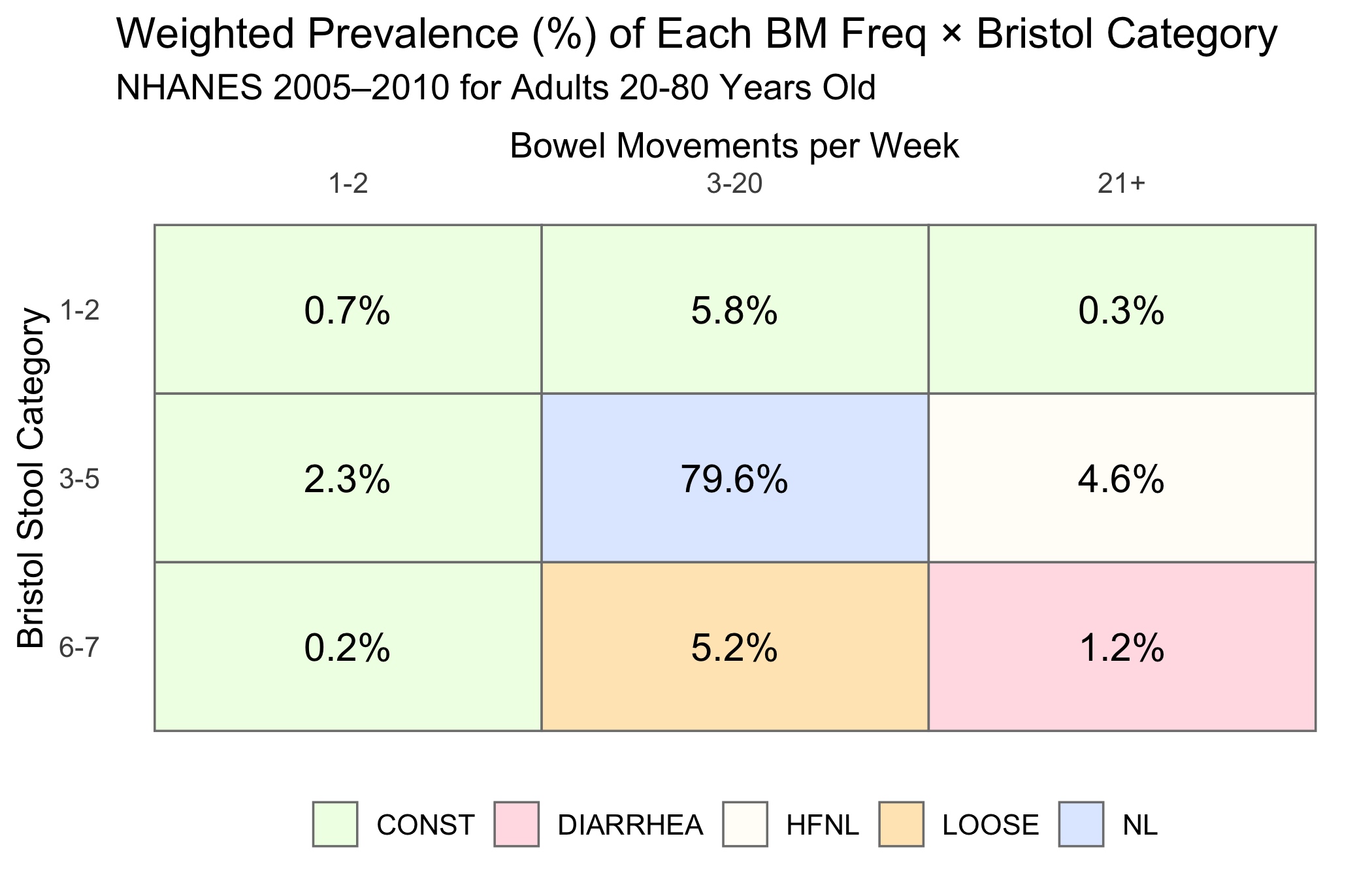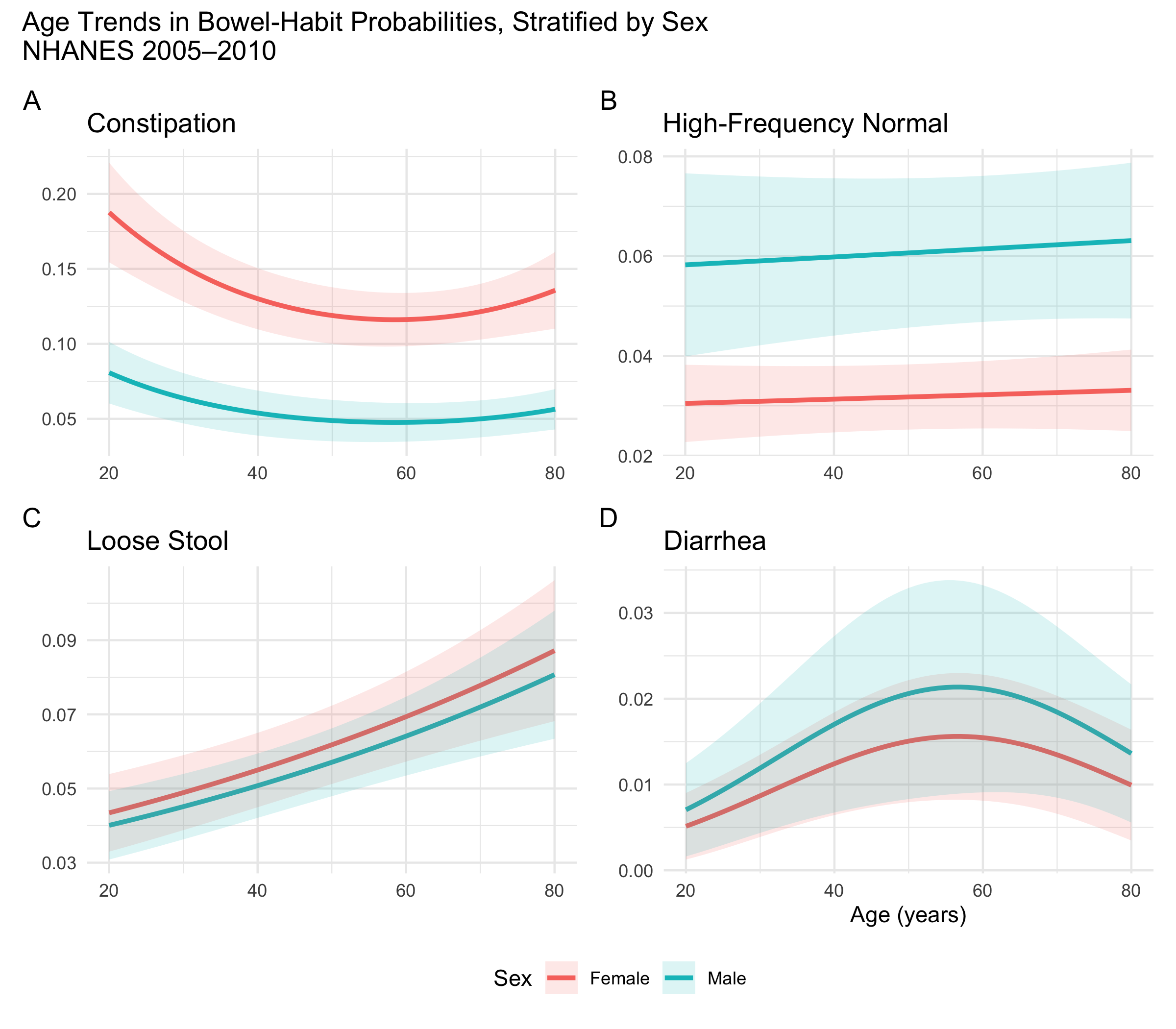Sunday Poster Session
Category: Functional Bowel Disease
P0792 - Nonlinear Association of Age With Bowel Habits and Its Modification by Sex in the NHANES (2005-2010)
Sunday, October 26, 2025
3:30 PM - 7:00 PM PDT
Location: Exhibit Hall

William Matloff, MD, PhD (he/him/his)
Banner - University of Arizona Tucson
Tucson, AZ
Presenting Author(s)
William Matloff, MD, PhD1, Daniel Matloff, MD, MS2
1Banner - University of Arizona Tucson, Tucson, AZ; 2University of Arizona College of Medicine, Tucson, AZ
Introduction: Abnormal bowel habits, such as constipation and diarrhea, are a common complaint in clinic. The association of age with bowel habits, and whether this association differs by sex, however, is not well characterized. While previous studies have focused on the prevalence and risk factors associated with bowel habits, we newly test the hypothesis that bowel habits are nonlinearly associated with age, and that this association differs by sex.
Methods: We used data from the 2005-2010 National Health and Nutrition Examination Survey (NHANES). Bowel habits were categorized using two survey questions: bowel movement (BM) frequency and most common stool type, as defined by the Bristol Stool Form Scale (BSFS). The categories were constipation (1-2 BM/week or BSFS 1-2), high-frequency normal (21+ BM/week and BSFS 3-5), loose (3-20 BM/week and BSFS 6-7), diarrhea (21+ BM/week and BSFS 6-7), and a normal reference group (3-20 BM/week and BSFS 3-5). We first estimated each group’s survey-weighted prevalence. We then used survey-weighted multivariable logistic regression models with linear and quadratic terms for age and their interactions with sex to test our hypothesis.
Results: The analytic sample comprised 13,722 adults aged 20-80 years. Weighted prevalences of the bowel-habit groups were as follows: normal, 79.6%; constipation, 9.4%; high-frequency normal, 4.6%; loose, 5.2%; and diarrhea, 1.2% (Figure 1). Age showed a quadratic association with constipation (p=3.2e-4) and diarrhea (p=5.7e-3), a positive linear association with loose stool (p=7.9e-5), and no association with high-frequency normal stool (p > 0.05). Age-by-sex interactions were not statistically significant for any of the groups, though the main effect of sex was significant for constipation and high-frequency normal stool. Females, relative to males, had higher odds of constipation (OR 2.6, 95% CI: 2.1-3.3, p=5e-10) and lower odds of high-frequency normal stool (OR 0.51, 95% CI: 0.38-0.68, p=4.4e-5). Predicted-probability curves for each group by age and sex are shown in Figure 2.
Discussion: In this nationally representative sample of U.S. adults, we found that age was nonlinearly associated with constipation and diarrhea and linearly associated with loose stool. While we did not find that this age-bowel habit association differed significantly by sex, men and women had significantly different odds of constipation and high-frequency normal stool. These results offer insight into how bowel habits vary across the life-span.

Figure: The survey-weighted prevalences of each defined bowel habit group. Const (Green) = Constipation, HFNL (Off-White) = High-Frequency Normal, NL (Blue) = Normal.

Figure: Plots showing the predicted probability of being in each bowel habit group by age and sex.
Disclosures:
William Matloff indicated no relevant financial relationships.
Daniel Matloff indicated no relevant financial relationships.
William Matloff, MD, PhD1, Daniel Matloff, MD, MS2. P0792 - Nonlinear Association of Age With Bowel Habits and Its Modification by Sex in the NHANES (2005-2010), ACG 2025 Annual Scientific Meeting Abstracts. Phoenix, AZ: American College of Gastroenterology.
1Banner - University of Arizona Tucson, Tucson, AZ; 2University of Arizona College of Medicine, Tucson, AZ
Introduction: Abnormal bowel habits, such as constipation and diarrhea, are a common complaint in clinic. The association of age with bowel habits, and whether this association differs by sex, however, is not well characterized. While previous studies have focused on the prevalence and risk factors associated with bowel habits, we newly test the hypothesis that bowel habits are nonlinearly associated with age, and that this association differs by sex.
Methods: We used data from the 2005-2010 National Health and Nutrition Examination Survey (NHANES). Bowel habits were categorized using two survey questions: bowel movement (BM) frequency and most common stool type, as defined by the Bristol Stool Form Scale (BSFS). The categories were constipation (1-2 BM/week or BSFS 1-2), high-frequency normal (21+ BM/week and BSFS 3-5), loose (3-20 BM/week and BSFS 6-7), diarrhea (21+ BM/week and BSFS 6-7), and a normal reference group (3-20 BM/week and BSFS 3-5). We first estimated each group’s survey-weighted prevalence. We then used survey-weighted multivariable logistic regression models with linear and quadratic terms for age and their interactions with sex to test our hypothesis.
Results: The analytic sample comprised 13,722 adults aged 20-80 years. Weighted prevalences of the bowel-habit groups were as follows: normal, 79.6%; constipation, 9.4%; high-frequency normal, 4.6%; loose, 5.2%; and diarrhea, 1.2% (Figure 1). Age showed a quadratic association with constipation (p=3.2e-4) and diarrhea (p=5.7e-3), a positive linear association with loose stool (p=7.9e-5), and no association with high-frequency normal stool (p > 0.05). Age-by-sex interactions were not statistically significant for any of the groups, though the main effect of sex was significant for constipation and high-frequency normal stool. Females, relative to males, had higher odds of constipation (OR 2.6, 95% CI: 2.1-3.3, p=5e-10) and lower odds of high-frequency normal stool (OR 0.51, 95% CI: 0.38-0.68, p=4.4e-5). Predicted-probability curves for each group by age and sex are shown in Figure 2.
Discussion: In this nationally representative sample of U.S. adults, we found that age was nonlinearly associated with constipation and diarrhea and linearly associated with loose stool. While we did not find that this age-bowel habit association differed significantly by sex, men and women had significantly different odds of constipation and high-frequency normal stool. These results offer insight into how bowel habits vary across the life-span.

Figure: The survey-weighted prevalences of each defined bowel habit group. Const (Green) = Constipation, HFNL (Off-White) = High-Frequency Normal, NL (Blue) = Normal.

Figure: Plots showing the predicted probability of being in each bowel habit group by age and sex.
Disclosures:
William Matloff indicated no relevant financial relationships.
Daniel Matloff indicated no relevant financial relationships.
William Matloff, MD, PhD1, Daniel Matloff, MD, MS2. P0792 - Nonlinear Association of Age With Bowel Habits and Its Modification by Sex in the NHANES (2005-2010), ACG 2025 Annual Scientific Meeting Abstracts. Phoenix, AZ: American College of Gastroenterology.
